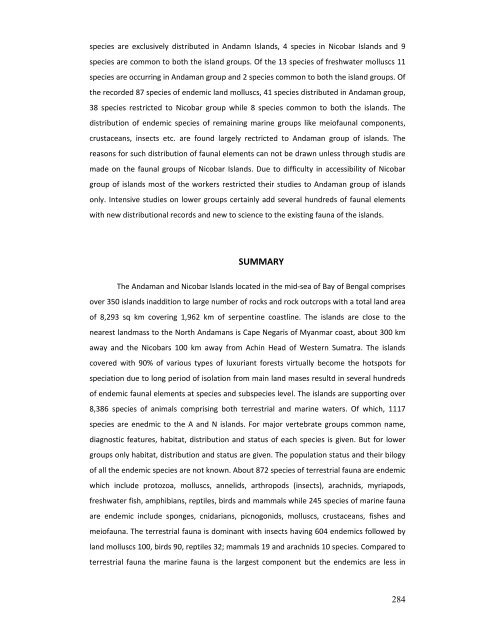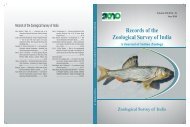Endemic Fauna of Andaman and Nicobar Islands Bay of Bengal
Endemic Fauna of Andaman and Nicobar Islands Bay of Bengal
Endemic Fauna of Andaman and Nicobar Islands Bay of Bengal
You also want an ePaper? Increase the reach of your titles
YUMPU automatically turns print PDFs into web optimized ePapers that Google loves.
species are exclusively distributed in Andamn Isl<strong>and</strong>s, 4 species in <strong>Nicobar</strong> Isl<strong>and</strong>s <strong>and</strong> 9<br />
species are common to both the isl<strong>and</strong> groups. Of the 13 species <strong>of</strong> freshwater molluscs 11<br />
species are occurring in <strong>Andaman</strong> group <strong>and</strong> 2 species common to both the isl<strong>and</strong> groups. Of<br />
the recorded 87 species <strong>of</strong> endemic l<strong>and</strong> molluscs, 41 species distributed in <strong>Andaman</strong> group,<br />
38 species restricted to <strong>Nicobar</strong> group while 8 species common to both the isl<strong>and</strong>s. The<br />
distribution <strong>of</strong> endemic species <strong>of</strong> remaining marine groups like mei<strong>of</strong>aunal components,<br />
crustaceans, insects etc. are found largely rectricted to <strong>Andaman</strong> group <strong>of</strong> isl<strong>and</strong>s. The<br />
reasons for such distribution <strong>of</strong> faunal elements can not be drawn unless through studis are<br />
made on the faunal groups <strong>of</strong> <strong>Nicobar</strong> Isl<strong>and</strong>s. Due to difficulty in accessibility <strong>of</strong> <strong>Nicobar</strong><br />
group <strong>of</strong> isl<strong>and</strong>s most <strong>of</strong> the workers restricted their studies to <strong>Andaman</strong> group <strong>of</strong> isl<strong>and</strong>s<br />
only. Intensive studies on lower groups certainly add several hundreds <strong>of</strong> faunal elements<br />
with new distributional records <strong>and</strong> new to science to the existing fauna <strong>of</strong> the isl<strong>and</strong>s.<br />
SUMMARY<br />
The <strong>Andaman</strong> <strong>and</strong> <strong>Nicobar</strong> Isl<strong>and</strong>s located in the mid-sea <strong>of</strong> <strong>Bay</strong> <strong>of</strong> <strong>Bengal</strong> comprises<br />
over 350 isl<strong>and</strong>s inaddition to large number <strong>of</strong> rocks <strong>and</strong> rock outcrops with a total l<strong>and</strong> area<br />
<strong>of</strong> 8,293 sq km covering 1,962 km <strong>of</strong> serpentine coastline. The isl<strong>and</strong>s are close to the<br />
nearest l<strong>and</strong>mass to the North <strong>Andaman</strong>s is Cape Negaris <strong>of</strong> Myanmar coast, about 300 km<br />
away <strong>and</strong> the <strong>Nicobar</strong>s 100 km away from Achin Head <strong>of</strong> Western Sumatra. The isl<strong>and</strong>s<br />
covered with 90% <strong>of</strong> various types <strong>of</strong> luxuriant forests virtually become the hotspots for<br />
speciation due to long period <strong>of</strong> isolation from main l<strong>and</strong> mases resultd in several hundreds<br />
<strong>of</strong> endemic faunal elements at species <strong>and</strong> subspecies level. The isl<strong>and</strong>s are supporting over<br />
8,386 species <strong>of</strong> animals comprising both terrestrial <strong>and</strong> marine waters. Of which, 1117<br />
species are enedmic to the A <strong>and</strong> N isl<strong>and</strong>s. For major vertebrate groups common name,<br />
diagnostic features, habitat, distribution <strong>and</strong> status <strong>of</strong> each species is given. But for lower<br />
groups only habitat, distribution <strong>and</strong> status are given. The population status <strong>and</strong> their bilogy<br />
<strong>of</strong> all the endemic species are not known. About 872 species <strong>of</strong> terrestrial fauna are endemic<br />
which include protozoa, molluscs, annelids, arthropods (insects), arachnids, myriapods,<br />
freshwater fish, amphibians, reptiles, birds <strong>and</strong> mammals while 245 species <strong>of</strong> marine fauna<br />
are endemic include sponges, cnidarians, picnogonids, molluscs, crustaceans, fishes <strong>and</strong><br />
mei<strong>of</strong>auna. The terrestrial fauna is dominant with insects having 604 endemics followed by<br />
l<strong>and</strong> molluscs 100, birds 90, reptiles 32; mammals 19 <strong>and</strong> arachnids 10 species. Compared to<br />
terrestrial fauna the marine fauna is the largest component but the endemics are less in<br />
284
















